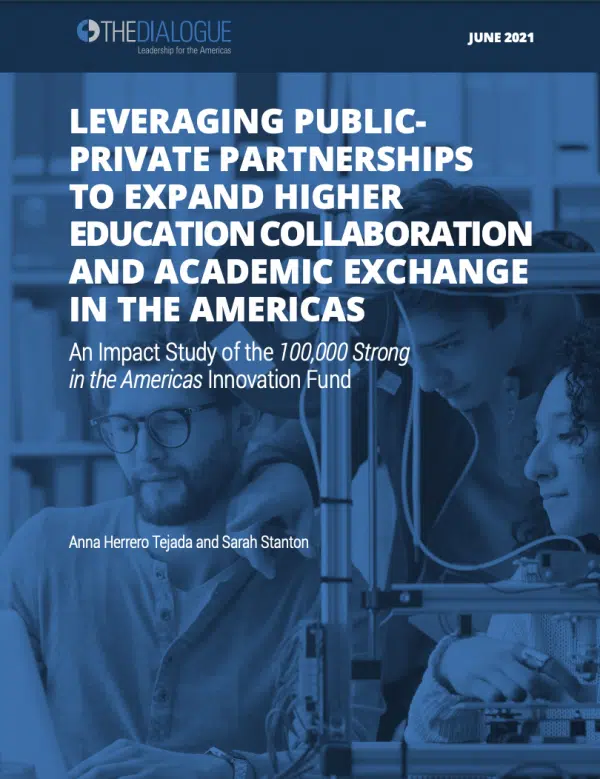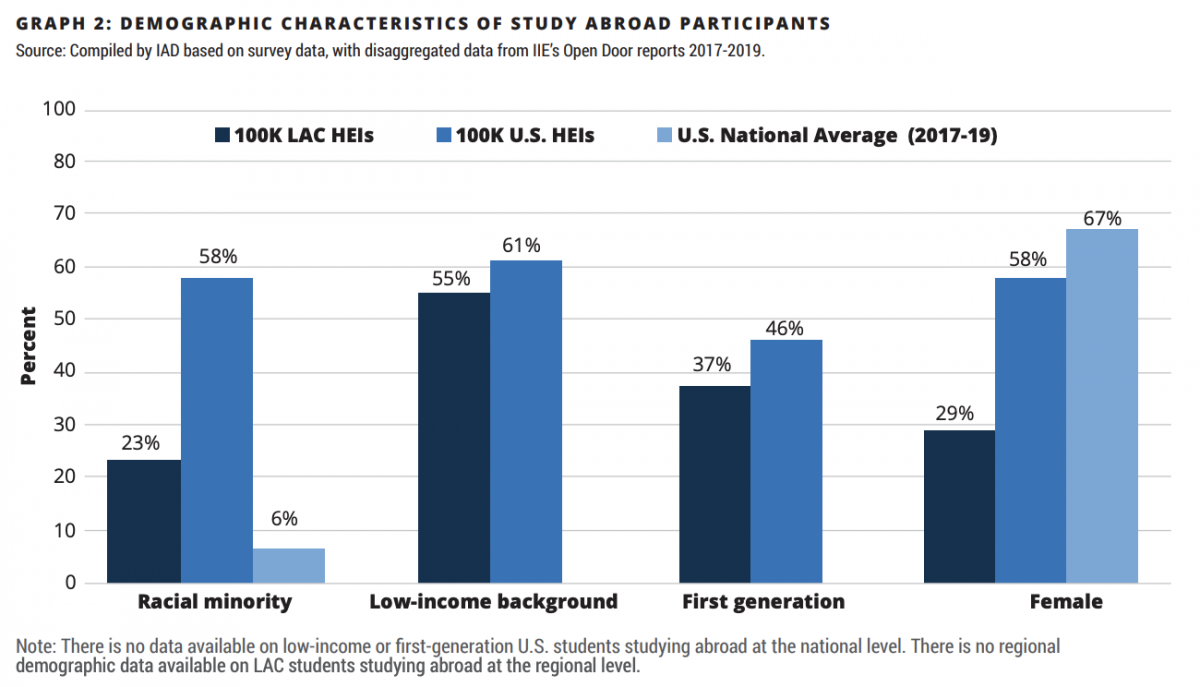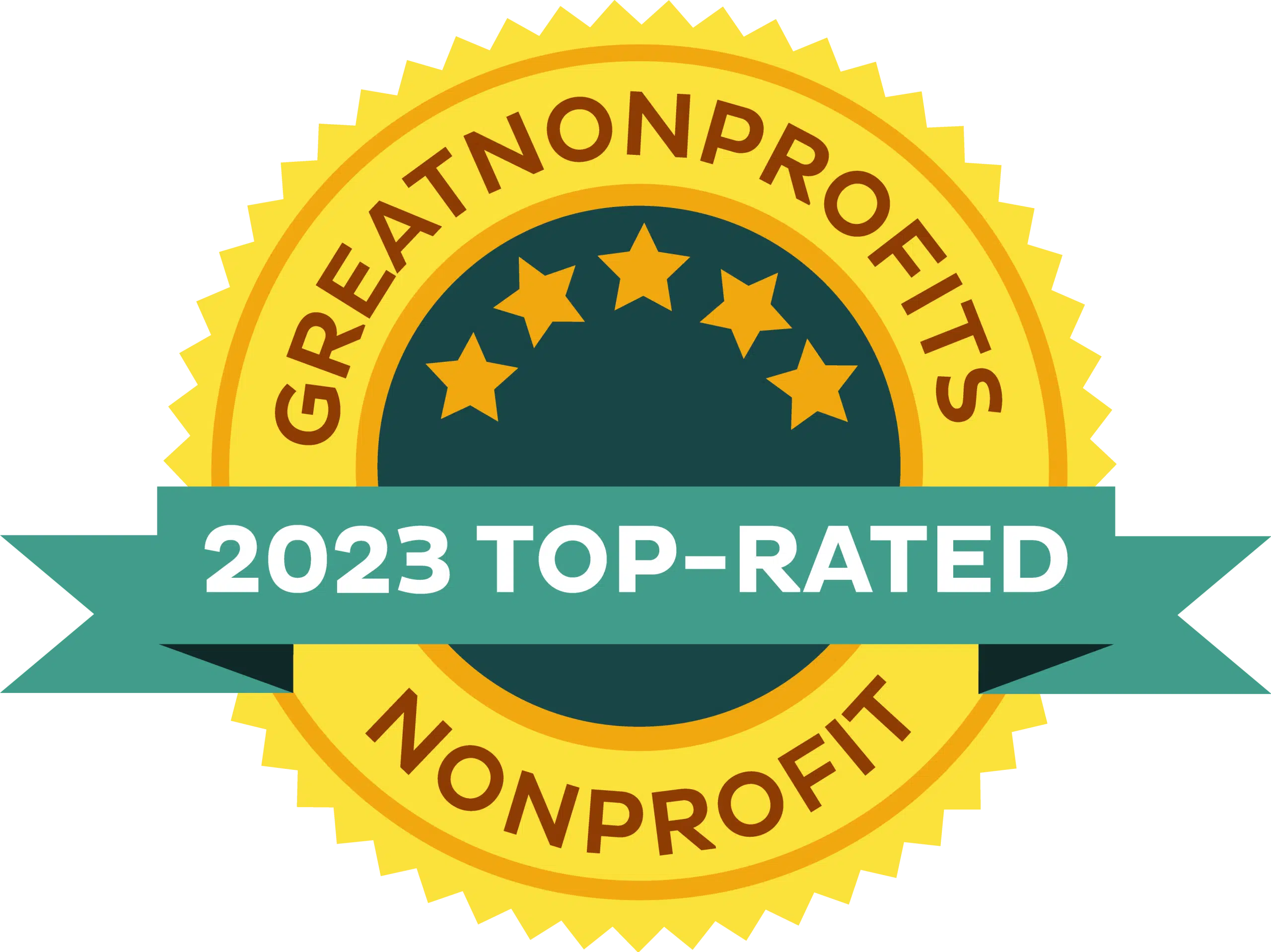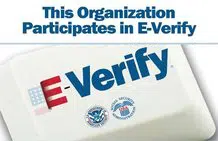On June 10, 2021, the Inter-American Dialogue (the Dialogue), a U.S.-based think tank located in Washington, D.C., gathered together distinguished panelists to discuss their recently published report, “Leveraging Public-Private Partnerships to Expand Higher Education Collaboration and Academic Exchange in the Americas: An Impact Study of the 100,000 Strong in the Americas Innovation Fund.”
The special event presented the findings of a new impact study that was conducted by the Inter-American Dialogue on the 100,000 Strong in the Americas (100K) Innovation Fund. Featured panelists included:
- Michael Shifter, President of the Inter-American Dialogue
- Julie Chung, Acting Assistant Secretary for the Bureau of Western Hemisphere Affairs at the U.S. Department of State
- Alfonso Quiñónez, Ambassador of Guatemala to the United States
- Paula Henao, Director of the Office of International Relations at the Instituto Colombiano de Crédito Educativo y Estudios Técnicos en el Exterior (ICETEX)
- John McPhail, President and CEO of Partners of the Americas
- Aaron Gorenc, Education Advocate at Fox Valley Technical College
- Jon Piechowski, Deputy Assistant Secretary for the Bureau of Western Hemisphere Affairs, U.S. Department of State
In addition, the report’s findings were presented by its authors from the Dialogue’s Education Program team:
- Ariel Fiszbein, Director of the Inter-American Dialogue Education Program
- Saran Stanton, Senior Associate for the Inter-American Dialogue Education Program
- Anna Herrero Tejada, Research Associate for the Inter-American Dialogue Education Program
The event was moderated by Roberta Jacobson, Former Member of the National Security Council & Former Assistant Secretary of State for the Bureau of Western Hemisphere Affairs.
Shifter gave opening remarks, followed by Assistant Secretary Chung, who highlighted the overall success of the 100K Innovation Fund initiative, in supporting long-term and sustainable hemispheric collaboration. Since its creation in 2013, the 100K Innovation Fund has awarded over 253 grants to 514 institutions in 25 countries and 49 U.S. states. The program has allowed for student training, workforce development programs, and innovative projects that have impacted the lives of thousands of students across the Americas. The 100K Innovation Fund has grown to over 2,300 higher education institutions, with over 1,000 universities and colleges in the United States.
Impact of 100K Innovation Fund
Following the opening remarks, impact report co-authors Tejada and Stanton discussed the three areas of program success that were identified through the impact study: (1) Student Development, taking into account both immediate skills and future professional development; (2) Higher Education Institutional Development and Growth, focusing on the strengthening of inter-departmental collaborations as well as external partnerships; and (3) Donor-Partner Engagement and Benefits, looking into the objectives and benefits of donor-partner contributions.
Student Development
The report confirms that 100K Innovation Fund programs allow students to develop sustainable connections and networking opportunities with fellow peers and faculty from host institutions. In some cases, students had the opportunity to collaborate on scientific research projects that were later published by the university. Students were also able to utilize skills they learned in their classrooms through real-world, case scenarios, giving them greater insight into their professional interests. Through cross-cultural experiences, students were able to gain a more globalized perspective and understanding of issues beyond their immediate surroundings. In some cases, students chose to continue focusing on Latin America and the Caribbean following their studies abroad. Participant demographics strategically emphasize the inclusivity of racial minorities, low-income, and first-generation students. As a result, 100K Innovation Fund programs often include both U.S. and Latin American/Caribbean students who had not previously had the opportunity to study abroad.
The impact study also found that the institutional partnerships that have resulted from the 100K Innovation Fund have allowed for impactful educational exchanges, particularly among students of diverse backgrounds. Through the eligibility requirements and conditions set forth in the Innovation Fund grant competitions, applicant and grant-winning institutions have achieved greater equity, inclusivity, and diversity within their campus and in the implementation of their 100K Innovation Fund program. According to the report, “Surveyed U.S. HEIs report that their 100K cohorts include racial minority student at a rate that is 52 percentage points higher than U.S. average study abroad programs.”
The following graph illustrates the demographic characteristics of students who participated in 100K Innovation Fund programs.
Students across the U.S., Latin America, and the Caribbean team up to discuss cross-regional problems and brainstorm innovative projects that can be applied both in the U.S. and Latin America contexts. Programs such as these expand the walls of a classroom as students partake in international experiential learning that takes into account technical, linguistic, and inter-cultural learning, which have become even more imperative as we continue to build a more globalized society and recover from current hardships, including the COVID-19 pandemic.
Higher Education Institutional Development & Growth
The study finds that 100K Innovation Fund grants have also helped to start new study abroad programs within different institutions. In some cases, the grant was the first step in establishing study abroad infrastructure, such as an office, system, or process. In other cases, it helped to secure internal funding for continued expansion/student access to study abroad programs, particularly in Latin American and the Caribbean. The study shows that a majority of the collaborations formed for the 100K Innovation Fund grant program, both internally and externally, were able to outlast the program timeline, which further demonstrates that the grants allowed for long-term sustainability and benefits, which can often be difficult to maintain for smaller institutions.
Donor-Partner Engagement & Benefits
Lastly, the report demonstrates a strengthening of bilateral relations between the U.S. government, private and public sector, and an overall positive impact by the 100K innovation Fund on public policy and the academic sector throughout the Western Hemisphere. As one of the regional governmental partners stated in the report, “Seeing (the grants) reach corners of the countries that we never thought this could be done, that was very gratifying.”
The study revealed that donor-partners were motivated to contribute and collaborate with the 100K Innovation Fund to promote positive key objectives within the initiative’s agenda, gain access to positive key policies within the academic sector, externalize grant funds, and strengthen their relationship with the U.S. government. Indeed, the 100K Innovation Fund opened doors for greater inclusion and transnational partnerships that otherwise would not have been possible.
Testimonials from Featured Panelists
After presenting the findings of the impact study, the panelists shared their own personal experiences with the 100K Innovation Fund, followed by a question-and-answer portion.
Guatemalan Ambassador to the U.S. Quiñónez shared his positive experience with the 100K Innovation Fund, first as a previous donor-partner during his time working at Cementos Progreso, one of the first companies in Central America that contributed to the 100K innovation Fund, and then in his current role as the Guatemalan Ambassador to the U.S. As a government official, Ambassador Quiñónez views the 100K Innovation Fund as an opportunity to advocate for greater intercultural exchange, particularly for Americans to come to Latin America and “gain an actual interaction with the people and the land.”
Henao, who has been involved with the 100K innovation Fund for over seven years through her role in various Colombian government educational agencies, shared her hesitancy at the beginning of the program as a too far wide-reaching goal. However, looking back, she shared the immense positive impact that the 100K Innovation Fund has had on Colombian students and its continued growth.
“It became a dream to become a part of the 100,000 Strong in the Americas program,” Henao said.
Gorenc from Fox Valley Technical College in Appleton, Wisconsin shared his experience as a 100K Innovation Fund grant recipient, stating increased visibility, professional development, and inter-cultural opportunities for both students and his community college’s study abroad office, which would not have been possible without the grant.
Moving Forward
The event concluded with a series of statements by the Dialogue and panelists on future recommendations for the 100K Innovation Fund to continue to build on its accomplishments and existing strengths. Recommendations focus on expanding the implementation of the 100K Innovation Fund program and leveraging donor-partnership opportunities.
Some of the recommendations include:
- Building a student alumni network for both U.S. and Latin American and Caribbean participants beyond the initial grant timeline. An alumni network will help to foster inter-regional partnerships and collaboration, as well as create professional development networking opportunities among students.
- Adding a mentorship or internship component to the 100K-funded exchange and training program at donor-partner organizations. The study reports that 67% of donor-partners would be interested in hiring or mentoring 100K Innovation Fund students. This could be an enriching opportunity for students, companies, and the overall 100K student program experience.
- Extending grants to cover two- to three-year funding cycles for institutions that do not have international education operations, such as a study abroad office. The study shows that the opportunities for HEIs to receive two or more grants have been a positive factor in sustaining Institution partnerships and student program opportunities particularly, for smaller institutions with limited funding resources.
- Creating a network for donor-partners to engage with each other and exchange best practices. Although events hosted by the 100K Innovation Fund have successfully connected donor-partners, some have expressed their desire to foster longer-lasting collaboration with their peers. This will allow the 100K Innovation Fund to function as a network of corporations, institutions, and foundations, and build a more sustainable community among donor-partners, gain name recognition, and attract new partners.
The 100K Innovation Fund is the leading hemispheric-wide initiative that strives to increase student training opportunities, solve real-world problems, and strengthen collaboration among governments, businesses, and academia. Through continued assessments of the initiative and recommendations, such as those provided in the Dialogue’s impact report, the 100K Innovation Fund will continue to build sustainable partnerships and increase investment in global skills for tomorrow’s workforce in the Americas.
Click here to read the full report, “Leveraging Public-Private Partnerships to Expand Higher Education Collaboration and Academic Exchange in the Americas”. Read it in Spanish here.





